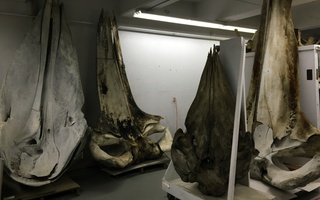{shortcode-deb123932c085b323272c833f1a92671c44df874}
Javier Ortega-Hernández, an Organismic and Evolutionary Biology professor at Harvard, reconstructed the history of the versatile organisms which lived more than half a billion years ago in his Wednesday evening lecture, “Wonderful Cambrian Beasts.”
The Harvard Museum of Natural History presented the lecture in a Zoom webinar as part of its ongoing Evolution Matters Lecture Series.
Ortega-Hernández, who also serves as curator of invertebrate paleontology at Harvard’s Museum of Comparative Zoology, researches the early origins and evolution of animals, particularly during the period known as the Cambrian explosion.
The Cambrian explosion was an event more than half a billion years ago in the fossil record when complex animal fossils appeared for the first time. In an interview before the event, Ortega-Hernández described it as a critical transitional period in the history of life on Earth
“Unlike other parts of paleontology, like dinosaurs, for example, not a ton of people necessarily are as familiar with the Cambrian explosion, even though it is massively important,” Ortega-Hernández said in an interview.
During the event, Ortega-Hernández described his research, which involves using unique biological features in fossils to pinpoint relationships between modern animals and those preserved in fossils. He pointed to the example of the link between Hallucigenia sparsa fossils recovered at a site in China and their modern-day counterpart, small invertebrates known as velvet worms.
By analyzing old fossil records, Ortega-Hernández, working alongside researchers in China, was able to identify the similar construction of claws and jaws in the two animals.
“The fossil record does play this pivotal part because it gives us a deep time perspective, which is really central towards understanding evolution,” Ortega-Hernández said.
Ortega-Hernández and the other researchers were able to take nearly flattened fossils and create 3-D models using imaging technology to breathe new life into the fossils of early animals. Ortega-Hernández encouraged those attending the lecture to access some of the models via QR code on their personal devices. Attendees were able to zoom in on highlighted features and rotate the models of the fossils.
“It's just a great opportunity for giving this kind of otherwise lesser-known [organism] a time to shine,” Ortega-Hernández said.
Read more in Faculty News
Embattled Chemistry Professor Charles Lieber Sues Harvard, Alleging University Required to Recoup Legal CostsRecommended Articles
-
What Happened to Vegitas?I have not yet heard a peer offer an alternative to the treatment animals in slaughterhouses receive as their necks are broken, throats are slit, and families are taken away.
-
Harvard Museum Official Finds Ancient Man's BoneA Harvard museum official has discovered a five-million year old bone of a primitive man. Arnold D. Lewis, head of
-
 Flying Treadmills, Cold War Whales: A Trip to Concord Field Station
Flying Treadmills, Cold War Whales: A Trip to Concord Field Station -
NOTED PHYSICIST TO SPEAKOne of the leading theoretical physicists of Europe. Professor Arnold Sommerfeld, of the University of Munich, Germany, will deliver the
-
What is Going on Today4.00-6.00.--University Tea in Phillips Brooks House. 4.55.--Zoological Club. "Some Fossils from Western Russia," by Professor P. E. Raymond, Zoological Laboratory,













